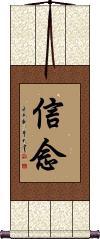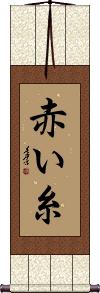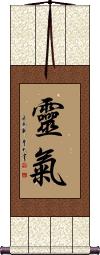Many custom options...
And formats...

Unseen in Chinese / Japanese...
Buy an Unseen calligraphy wall scroll here!
Personalize your custom “Unseen” project by clicking the button next to your favorite “Unseen” title below...
Faith / Trusting in the Unseen
信念 expresses the idea of “having a belief” or “trusting in the unseen.”
信念 could also be translated as beliefs or convictions.
Note: Also considered to be one of the Seven Heavenly Virtues.
See Also: Devotion | Dedication | Trust
The Red String
Thread of Lover's Destiny / Fate
This literally translates as “the red string” or “the red thread” in Japanese, but the real meaning is much deeper...
In Japanese culture, it's believed that fate, destiny, or karma joins lovers by an unseen string, tied around one little finger of each. 赤い糸 is how soul mates find and are drawn to each other.
The Japanese concept of the red thread of fate, by most estimations, comes from Chinese folklore, where it's known as 姻緣紅線. The only difference is that in China, the celestial red thread is tied around the ankles of the lovers (versus what is usually represented as the pinky finger in Japan).
Energy Sword Body in Concert
Spirit, Sword & Body as One
气剑体一致 often gets translated as “Mind Sword Body,” or “Spirit, Sword, and Body as One.” But I think these translations don't tell you enough about what this is really saying.
In this context, 気, which is the modern Japanese version of 氣, means spiritual and unseen energy or “life energy.” In some cases, 気 can be translated as spirit, feeling, or nature. If defined as the mind, it's more about the invisible or intangible parts of one's mind (or soul).
剣 is the Japanese version of 劍 meaning sword.
体 is the modern Japanese version of 體 meaning body.
The Kanji 一 means one, and in this case, suggests “all in one.”
The Kanji 到 means to send, deliver, or convey. But together, 一到 suggests all these things in agreement, union cooperation, or in concert.
Note: Arguments exist as to whether this should be romanized as Kikentaiitchi, Kikentaiicchi, or kikentaiichi. Technically, if you drop the last character, you get 気剣体一 and kikentaiichi (ki ken tai ichi), which is also a valid phrase.
Reiki
靈氣 is the title of a healing practice now found globally but with origins in Japan.
Special note: Outside of the context of the healing practice of Reiki, this means “aura” or “spiritual essence that surrounds all living things.” A Japanese person unfamiliar with the practice will take the “aura” meaning.
Reiki is a technique for stress reduction and relaxation that also heals. It can be compared to massage but is based on the idea that an unseen “life force energy” flows through us and is what causes us to be alive. If your life force energy is low, you'll be more likely to get sick or feel stressed. If your life force energy is abundant and flowing well, you become more capable of being happy and healthy.
There is a lot of information available if you want to Google this term - my job is to offer the calligraphy while you can decide if it is right for you.
Note: We are showing the ancient (traditional) form of the Reiki Kanji. I have seen Reiki written with the slightly simplified version and this more classic form. If you want the form of Reiki with the two strokes in the shape of an X on the second character and the modern first character, simply click on the Kanji characters to the right.
Note: 靈氣 is also a Chinese word, but in Chinese, these characters create a word that refers to a smart person or someone with high aspirations. It is not read as a healing method in Chinese.
In Korean Hanja, this can be read as a “mysterious atmosphere” by a Korean who is not familiar with the practice of Reiki (still has a cool meaning in Korean).
Not the results for unseen that you were looking for?
Below are some entries from our dictionary that may match your unseen search...
| Characters If shown, 2nd row is Simp. Chinese |
Pronunciation Romanization |
Simple Dictionary Definition |
赤い糸 see styles |
akaiito / akaito あかいいと |
More info & calligraphy: The Red String |
冥感 see styles |
míng gǎn ming2 gan3 ming kan myōkan |
unseen aid |
冥護 冥护 see styles |
míng hù ming2 hu4 ming hu myougo; meigo / myogo; mego みょうご; めいご |
secret aid by the gods unseen aid |
出沒 出没 see styles |
chū mò chu1 mo4 ch`u mo chu mo |
to come and go; to roam about (mostly unseen); (of a ghost) to haunt (a place); (of a criminal) to stalk (the streets); (of the sun) to rise and set See: 出没 |
未見 未见 see styles |
wèi jiàn wei4 jian4 wei chien miken みけん |
(adj-no,n) not yet seen; unseen; unacquainted; unknown does not [yet] see |
通底 see styles |
tsuutei / tsute つうてい |
(n,vs,vi) being connected at a fundamental level; having an unseen commonality; underlying (both) |
可視化 可视化 see styles |
kě shì huà ke3 shi4 hua4 k`o shih hua ko shih hua kashika かしか |
visualization (noun, transitive verb) (1) visualization (of data, results, etc.); visualisation; (noun, transitive verb) (2) making visible (something that was previously unseen); (noun, transitive verb) (3) recording (a police interrogation) |
見残し see styles |
minokoshi みのこし |
leaving something unseen; things unseen; (personal name) Minokoshi |
見残す see styles |
minokosu みのこす |
(transitive verb) to leave unseen or unread |
人知れず see styles |
hitoshirezu ひとしれず |
(exp,adv) secretly; in secret; unseen; unobserved; inwardly; in private |
人知れぬ see styles |
hitoshirenu ひとしれぬ |
(pre-noun adjective) secret; hidden; unseen; inward |
冥冥之中 see styles |
míng míng zhī zhōng ming2 ming2 zhi1 zhong1 ming ming chih chung |
in the unseen world of spirits; mysteriously and inexorably |
居もしない see styles |
imoshinai いもしない |
(exp,adj-i) (1) (kana only) (emphatic form of 居ない) invisible; unseen; (exp,adj-i) (2) vague; mysterious; (exp,adj-i) (3) imaginary |
眼不見為淨 眼不见为净 see styles |
yǎn bù jiàn wéi jìng yan3 bu4 jian4 wei2 jing4 yen pu chien wei ching |
what remains unseen is deemed to be clean; what the eye doesn't see, the heart doesn't grieve over (idiom) |
運命の赤い糸 see styles |
unmeinoakaiito / unmenoakaito うんめいのあかいいと |
(exp,n) (See 赤い糸) red string of fate; in Chinese-Japanese folklore, fated lovers were said to be joined by an unseen red string, tied around one little finger of each |
Variations: |
noorukku; noo rukku ノールック; ノー・ルック |
(n,adj-f) (1) (usu. as 〜で) (while) not looking (eng: no look); (doing) without looking; (2) (buying) sight unseen; not seeing in person |
The following table may be helpful for those studying Chinese or Japanese...
| Title | Characters | Romaji (Romanized Japanese) | Various forms of Romanized Chinese | |
| Faith Trusting in the Unseen | 信念 | shinnen | xìn niàn / xin4 nian4 / xin nian / xinnian | hsin nien / hsinnien |
| The Red String | 赤い糸 | akai ito / akaiito | ||
| Energy Sword Body in Concert | 気剣体一致 / 氣劍體一致 气剑体一致 | ki ken tai icchi kikentaiicchi ki ken tai ichi | ||
| Reiki | 靈氣 灵气 霊気 | reiki | líng qì / ling2 qi4 / ling qi / lingqi | ling ch`i / lingchi / ling chi |
| In some entries above you will see that characters have different versions above and below a line. In these cases, the characters above the line are Traditional Chinese, while the ones below are Simplified Chinese. | ||||
Successful Chinese Character and Japanese Kanji calligraphy searches within the last few hours...







